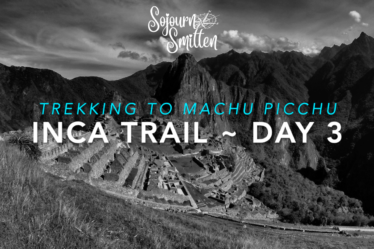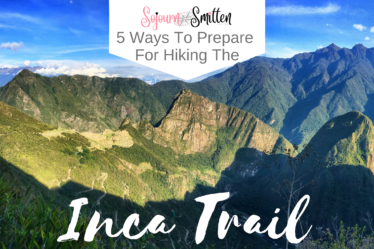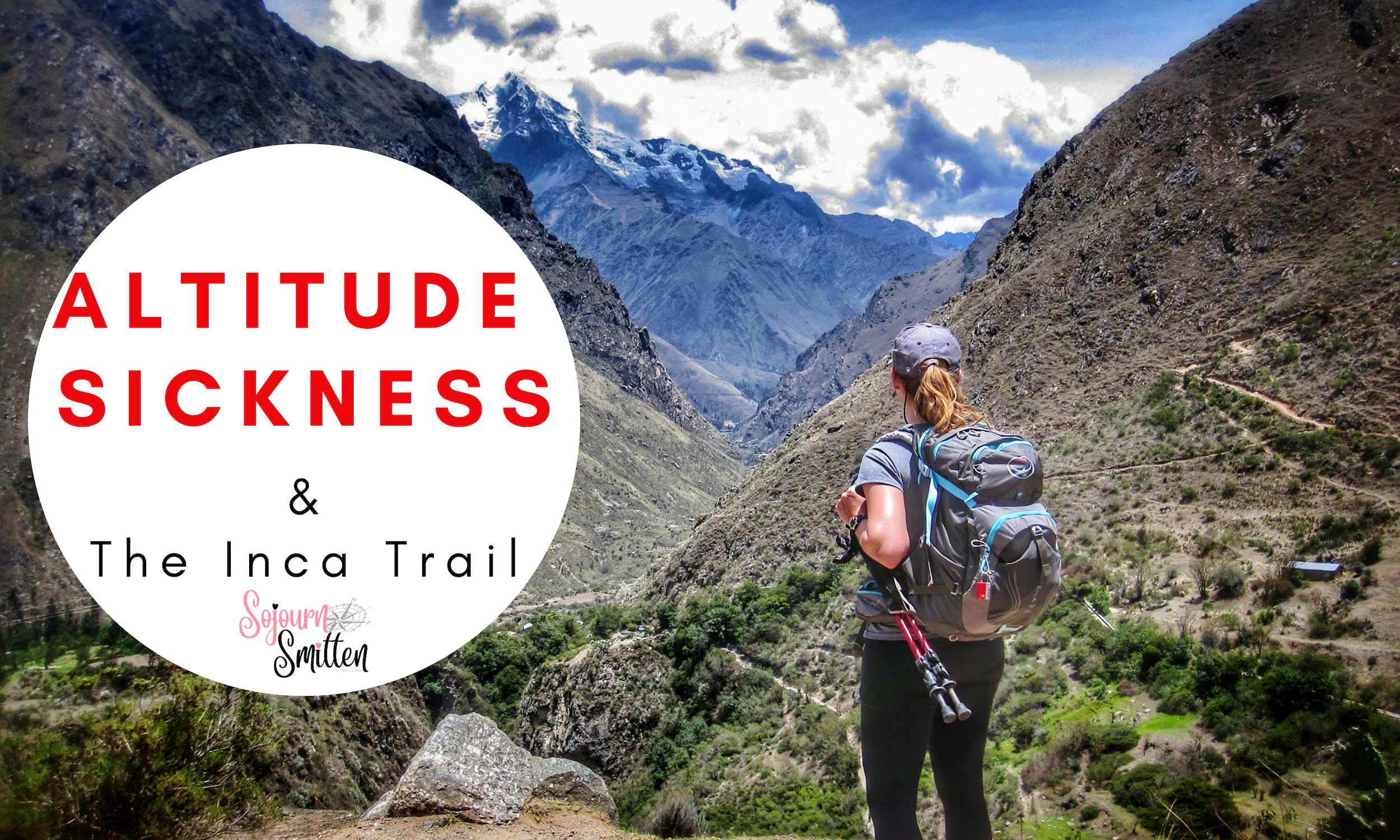
First off, it’s important to know that…yes, although hiking the Inca Trail is challenging, it is also very rewarding! This post is mainly to provide a place to consolidate my research on altitude sickness and information on ways to try and avoid it. After all, you paid a chunk of money to get to Peru and another chunk on the Inca Trail permit, so if you’re anything like me, you don’t want the whole trip to be squashed by some altitude sickness.
Once you start reading about altitude sickness it can sound pretty scary. However, don’t let it get bigger in your head than it really is. Yes, you should take it seriously, but if you take the right precautions, then you shouldn’t have anything to worry about.
There Are Three Kinds of Altitude Sickness
Apparently, there are three types of altitude sickness, also called soroche in Spanish: Acute Mountain Sickness (AMS), High-Altitude Pulmonary Edema (HAPE) and High-Altitude Cerebral Edema (HACE). Out of all of them, the most common and the least dangerous is AMS. The other two are extremely rare but can be fatal, so while you should take preparations seriously, in all honesty you should be fine…after all, it’s not like you are climbing Mt. Everest.
What Is Altitude Sickness, Exactly?
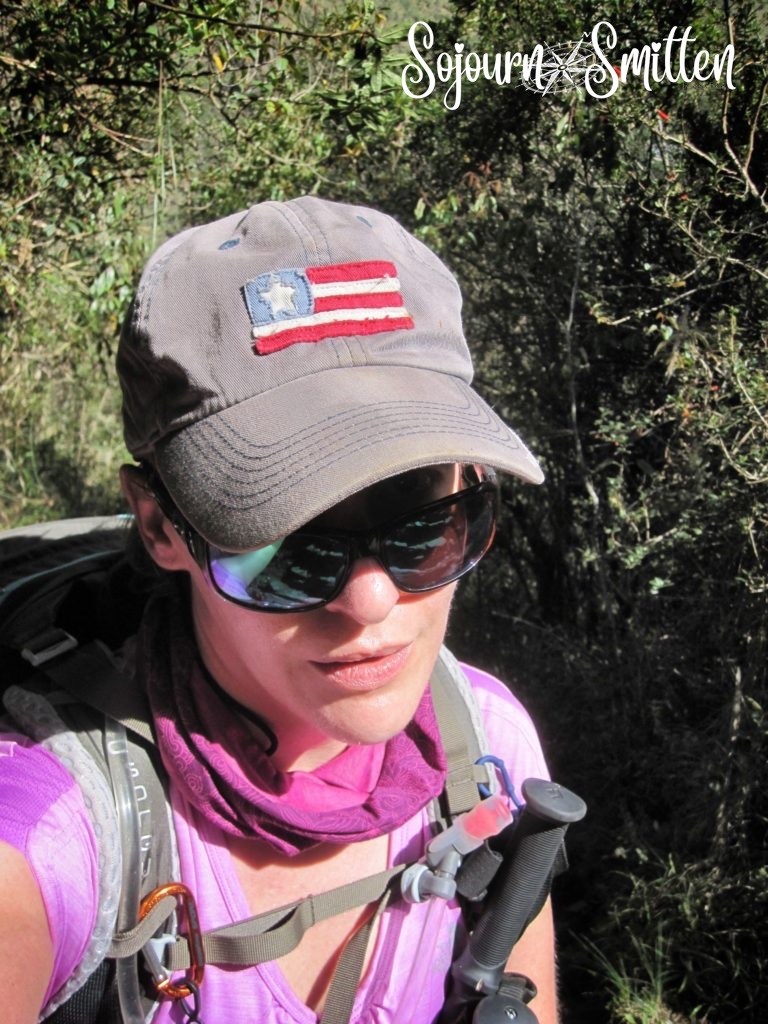
AMS is caused by rapid exposure to low amounts of oxygen at high elevation. Symptoms may include headaches, vomiting, tiredness, trouble sleeping, and dizziness. All of which could last anywhere from 12 hours to four days. It may start out like you have a hangover (dizzy, headache, nausea), and then go away after you acclimatize. Then again, if your symptoms aren’t relieved by over-the-counter medications and progressively get worse after a day or two…to where you have a severe headache, tightening in your chest or have trouble walking or thinking clearly, then your case is more moderate to severe and you and your guide need to discuss your situation. Moderate and extreme cases are rare, but can effect even the most athletic individual…so just be aware of your body and let your guide know what’s going on.
Day 1 – Elevation on the Inca Trail
Mild symptoms of altitude sickness can begin as low as 5,000 feet (1,500 meters) and on Day 1 of the Inca Trail you’re already starting out at almost 9,000 feet (2,700 meters).
I know from experience we had two hikers in my group that were struggling with some mild AMS on Day 1 that included at least headaches and nausea. Climbing 2,000 feet (600 meters) under a hot sun after little to no sleep, and eating a heavy meal the night before, can mess with your body and it’s ability to get enough oxygen. So, tip No. 1…try to get a good rest the night before, if you can…I know it’s hard with all the packing, anticipation and 3am wake-up call ;). Believe me…I may have had 1.5 hours of sleep myself and wish I could have had more going into Day 1.
DAY 1
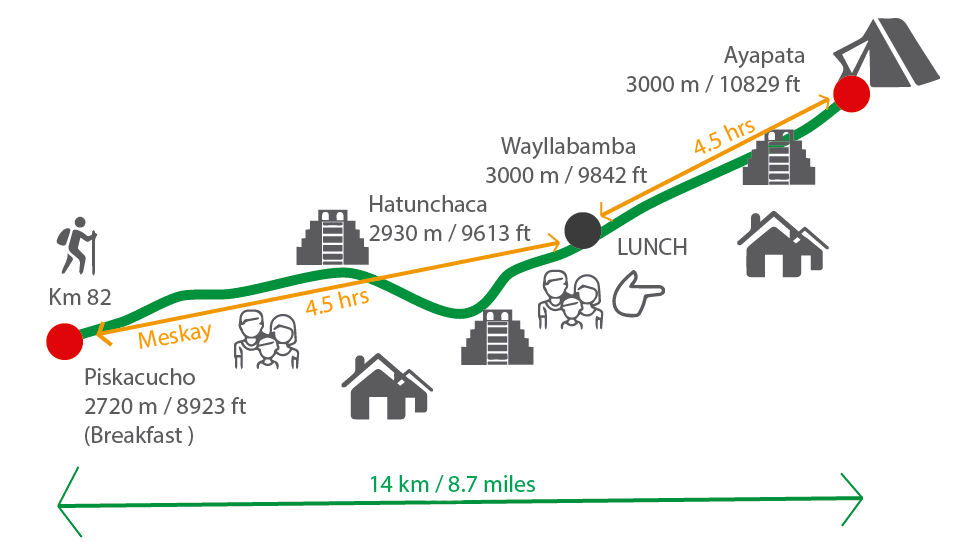
Day 2 – Elevation on the Inca Trail
The elevation change on Day 2, trekking for 4 hours up almost 3,000 feet (914 meters), is the biggest push on the 4 Day Inca Trail and could be the time where you may feel some altitude sickness symptoms. My group still had two hikers that weren’t feeling that great, but they did make it up Dead Woman’s Pass (yeah, don’t you love the name?!). The rest of us struggled on little sleep and were short of breath, but no other extreme effects. The only symptom for me, besides shortness of breath was my hands swelled, but I couldn’t tell if it was the altitude, sunburn (the sun is crazy intense here), or a combination of both.
DAY 2

Really, after you’ve reached the top of Dead Woman’s Pass, you’ll be ecstatic and relieved all at once! Ecstatic that you made it without giving up and relieved that (for the most part) it’s all downhill from here… or at least not as crazy as the beginning of Day 2. LOL!

Day 3 – Elevation on the Inca Trail
DAY 3

Days 3 and 4 are your more enjoyable days. These are the days you’ll feel like you can look up from your feet and check out your surroundings. These are also the days that you should feel better if you had any altitude sickness symptoms, because your body is finally getting acclimatized and there’s not as much elevation change. And, of course, Day 4 is what you’ve been waiting to see so all the struggling was worth it!
On Day 3 you only climb around 300 feet (91 meters) followed by a descent of 3,117 feet (950 meters).
Day 4 – Elevation on the Inca Trail
On Day 4, you start out going pretty flat with some steeps steps here and there…the last being the “Gringo Killers” up to the Sun Gate. However, by the time you reach Machu Picchu you’ve descended 1,083 feet (330 meters).
DAY 4

So now that we’ve covered just a taste of what elevations you’ll have to conquer and what altitude sickness can look like…let’s talk about some of the ways you can avoid feeling ill.
TAKING PRECAUTIONS AGAINST ALTITUDE SICKNESS
Some people suggest after arriving in Cusco that sits at 11,200 feet (3,400 meters) you should immediately go to a lower elevation like Ollantaytambo that sits at 9,160 feet (2,792 meters) to stay for the first night, however I didn’t do this, and I was fine. That’s not to say I didn’t feel the change in altitude. The most noticeable was finding it harder to breathe as I walked up a slight incline from my hotel to the main center plaza…but that was the extent of it.
So how to avoid the dreaded effects…well, listed below are just some of the things I tried.
6 Ways To Prevent Altitude Sickness On The Inca Trail
1) ChlorOxygen Chlorophyll Concentrate Drops:
One week before my flight out of the States, I began taking ChlorOxygen Chlorophyll Concentrate Drops. In my research, I found a few people claiming this helped them with the altitude. Now, I don’t know if it really works, but I was looking for any and all ways to not spoil my trip with altitude sickness. The benefit of taking this is it’s supposed to increase the amount of oxygen available to cells. Thus, lowering your risk for problems, like headaches, fatigue, and nausea.
Click here to get yours: https://www.amazon.com/ChlorOxygen-Chlorophyll-Concentrate-Dietary-Supplement-x/dp/B000Q3BZOQ/ref=sr_1_4_a_it?ie=UTF8&qid=1546996705&sr=8-4&keywords=ChlorOxygen+Chlorophyll#customerReviews
2) Acetazolamide Pills (Brand Name, Diamox):
This is a “water pill” (prescription required) used to prevent and reduce the symptoms of altitude sickness. It’s recommended to start taking this 1 or 2 days before your ascent. Since Cusco is at a high elevation…start the pills before you arrive. Basically when you land in Lima, Peru take a pill. You then have to continue taking until you’ve reached your highest elevation, so after Dead Woman’s Pass. Tip…do not take on an empty stomach. I learned this the hard way…my first morning in Cusco I took it before breakfast and had the worst stomachache. I quickly went and ate something and felt immediately better.
Note: If you decide not to get a prescription before your trip but then feel you need some “water pills” after arriving in Cusco, then you’ll need to search for Soroche Pills, this is the Spanish name for altitude sickness.
3) Coca Tea, Coca Leaves or Coca Candies:

Once you arrive at your hotel (or wherever you stay) in Cusco, it’s strongly suggested to grab a cup of Coca Tea. For centuries, coca tea has been used in South America to alleviate symptoms of altitude sickness, like nausea and diarrhea. Again, I couldn’t tell if drinking this every morning did anything for me, but it helped me stay hydrated and I definitely didn’t get sick…so maybe there is something to it. I also felt a little boost of energy afterwards.
You can also buy either Coca Leaves or Coca Candies in Cusco before your hike begins. Your hiking company may also have them available. I tried both, especially on Day 2. Our hiking company had Coca leaves available on the morning of Day 2, so I stuck a wad in my cheek, occasionally sucking on the juice as I began my hike. I broke out the Coca candy I had purchased in Cusco for my last two hours of hiking up to Dead Woman’s Pass. They may or may not give you a jolt of energy…but they do take your mind off the boot trudging.
When walking the streets of Cusco, you will often see the locals chewing the leaves and drinking the tea to start their day. Coca leaves were long held as sacred to the locals and they believed that they held many healing powers. That’s why even today it is recommended to use the Coca leaves for a headache, sore throat or stomach issues.
4) Bland Diet:
It makes sense to be wary of eating any type of heavy meals or foreign meat dishes while you are acclimatizing in Cusco. So it may be good to stick to soups, pasta, and sandwiches the first day. On the second day I did try the popular Peruvian Lomo Saltado (stir-fried steak)…delish!! But, I’d probably recommend saving the Cuy (guinea pig) for after your trek is over. 😉
5) Drink Water:
Staying adequately hydrated is a daily task, but even more important while hiking. You should aim to drink two to three liters of water a day to prepare for your trip. Dehydration decreases the body’s ability to acclimatize to higher altitudes.
6) Hike At Your Own Pace:
The Inca Trail is not a race to the top…it’s about the journey. You’ll have some in your group that act like it’s a walk in the park while others have more of a challenge. Just take it one step at a time…and find your place in the pack. My place was like fourth from the last while I let all the 20 somethings and very fit europeans go in front of me. 😉 Taking it slow is also good if you happen to get sick and the best thing to do is get into a pattern. For instance, try taking a few steps, pause to breathe, then a few more steps and breathe again. Slow and easy my friends…slow and easy.

Altitude sickness & the Inca Trail is tricky and as mentioned, can strike anyone…even the fittest Olympic athlete. This is the one thing you really can’t train for in advance. All you can do is try to take precautions, know the symptoms, and hope for the best. Just know that you can do the hike as long as you go at your own pace…and start exercising well before you go.
To learn more about how to Physically Prepare for hiking the Inca Trail – Click Here.

